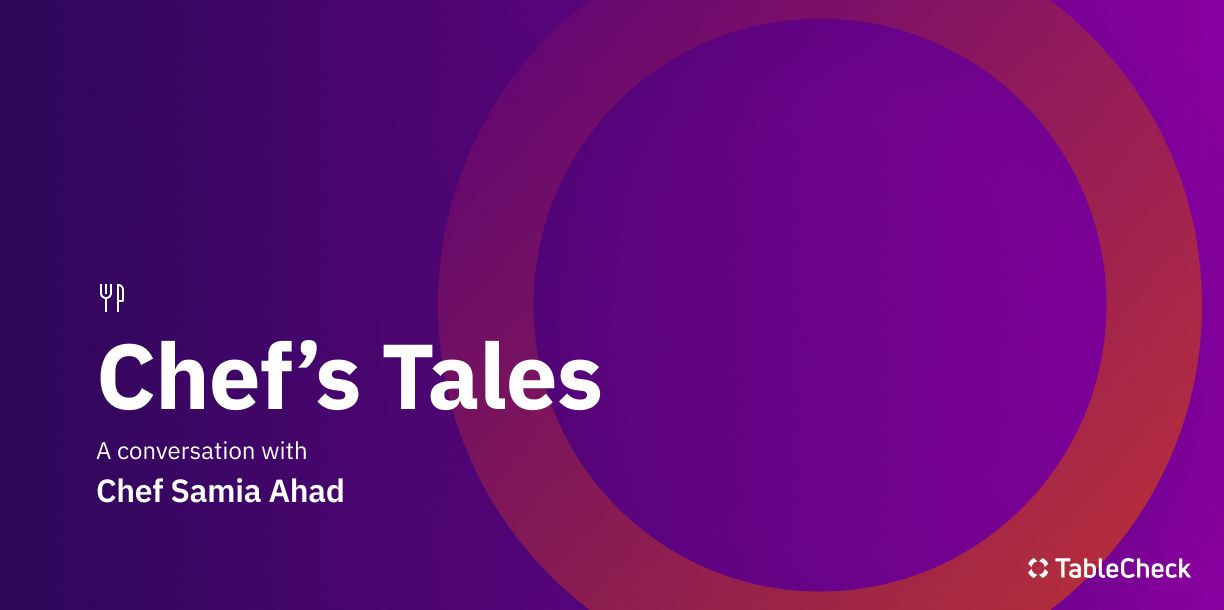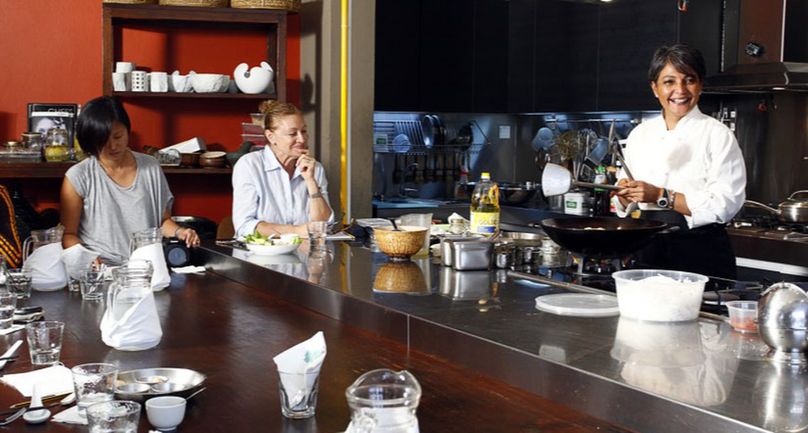Chef Samai Ahad: My heart and soul lies in Asian cooking
The Singapore-based chef talks about her career to date and what it means to be one of the pioneers of pan-Asian cooking

Chef Samia Ahad opened the Singapore restaurant Coriander Leaf in Singapore in 2001. Coming to professional cooking when she was in her thirties, Ahad worked in New York and London before moving to Singapore specializing in pan-Asian cooking. Alongside Coriander Leaf, Ahad opened The Screening Room in 2011, a multi-purpose restaurant and movie screening theatre. Ahad has been credited with opening one of Singapore's first multi-concept restaurants, and regularly runs popular cooking classes and team-building workshops in both Coriander Leaf and The Screening Room.
What is Singapore like in comparison to New York? What makes Singapore unique as a dining scene?
I've been in Singapore for 20 years now, and there's been a huge change. When I first came here the food scene was quite dismal. Now it's just exploded, in fact, it's oversaturated. Singapore's so small, it's a tiny market and you've got dozens of great options, between the local food, the cheap food, and the fine dining/ mid-range. There's been a huge shift, and I think palettes have also become more sophisticated in the last five to eight years. It's one of the toughest markets I've ever worked in. With Singapore's restaurant scene, what kills you are the rents and the HR problem (in this industry wherever you are, all over the world, it's a revolving door).
Rents are high everywhere, like Tokyo, Hong Kong, London, but you have the market there which you don't have in Singapore. It's very hard to do turns: I don't care if you are a McDonald's or fine dining–in this business it's all about volume. If you don't get the turns and don't get the volume, it makes it that much more challenging. I've also seen another trend in Singapore over the last five years which is all the restaurants now belong to groups. There are very very few single owner restaurants. Being part of a group, you get economies of scale and a lot of advantages.
What motivated you to start that Coriander Leaf and did you have that vision at the time of having multiple different elements to them?
No, when I opened Coriander Leaf, I actually never really wanted to open a restaurant, as my real passion is teaching. I just wanted to open a cooking school; but at that time in 2001, the market was pretty dismal and it just didn't work as a standalone business, so I was sort of forced into opening the restaurant. The school was always part of my concept.
I opened in 2001 two months before 9/11, so the market crashed, and I was an unknown [chef] who hadn't been in Singapore that long. My network, both socially and in the food scene, was pretty much zero. I was in a terrible location at the time, it had potential but with the market crashing. That potential pretty much went out of the window. As we got over that and started making a name for ourselves, SARs happened. A huge amount of restaurants closed but we survived that as well. The first couple of years, the fact that I survived, was an achievement in itself.
Looking back, how did you survive those first years?
It was because I was doing multiple things–if I'd just been a restaurant I wouldn't have been able to survive it. One aspect fed the other: if people weren't coming to the restaurant, I was doing cooking courses, and the team-building classes, which really took off. I was also offering catering, which initially I used as a marketing tool. It got the word out and it was often how people found out about the restaurant, so I think it was the diversity to which I can attribute our survival too.

What motivated you to open the Screening Room?
That opened in 2007, and with that, I was fueling my other passion, which is movies. I always say if anyone wants a quick 101 on culture, what do you do? You taste their food and you watch their movies. On the second floor, we have a studio space which is whatever the customer wants it to be. The ground floor is the restaurant and on the basement, we have a cocktail bar, so it really became a multi-media hub. The second floor can be used as a studio, so we offer team-building through movie making. Through that, I've created a very loyal corporate clientele, who come to me for multiple things. I've always had the philosophy that every customer has five faces. You can appeal to different aspects: you go out to dine with your boyfriend or girlfriend, you join your mother for a cooking class, and join your colleagues for a team building session. I sort of made four or five customers out of one customer.
Your food covers many different locations too. The menu is specifically designed to be pan-Asian: how did you create that?
My professional training is classical French, but my heart and soul lies in Asian cooking. I think that's where the flavors are, that's where the culture is. I actually owe my repertoire to my initial cooking class students I started when I had just moved to Singapore. I had made a bunch of friends and because they knew my background as a chef, they started asking for cooking lessons, so I began at home with a group of six people, and the same six people were still coming to me for lessons two years later once a week. Every time I taught them they'd ask me what I'd be teaching them next week. They'd ask to learn about Turkish food or Middle Eastern food etc, and I've always believed that in order to teach you have to learn yourself, so it kept my learning going and it expanded my repertoire.
I went out and learned about what people wanted to know more about. At Coriander Leaf, we span the breadth of Asia, I was trying to change the perception as to where Asia actually is. When you say Asia, people think South-East, but if you look at the map, it actually starts in Turkey and ends with Japan. You also have the Middle East etc. So I struggle to this day with people thinking we're a specific cuisine.
Do you consider it 'fusion' food?
I know people confuse it and sometimes call us 'fusion'. Fusion is for me the culinary f-word. I am a bit of a purist, so if I am doing a Thai dish, it is Thai. The only way I would say sometimes 'fusion' is–I may borrow a technique from another cuisine–but it's certainly not in the flavor and the palette. I think there are very few chefs that can do fusion well. A lot of chefs have dabbled in it; they come across an ingredient, and then they try and infuse it into a French dish for example. To me, it just doesn't make sense. I don't think you're representing either cuisine properly or with integrity. There are some cultures, Singapore for example, where the natural food is true fusion; it's a marriage of Chinese, Indian and Malay, but I don't believe I do fusion well, so why should I do it? You really have to understand the ingredient, not just put it in just for the sake of it.
Is the menu you have now similar to when you began?
No, it's really evolved now in the last 3 or four years. I would say 20% of my menu still has what I had on day 1. I always spanned the breadth of Asia but initially, I took on a Western format of appetizer, main course, dessert, etc. I've actually gone back to the traditional way of serving Asian food family style because I believe that's the way Asian food is meant to be eaten. Trends have also changed: people now want to share, which is what food is all about.
"I've gone deeper into my concept about what is food about: it's not just food, it's about sharing a table, breaking bread together, sharing experiences."
You're the head of your restaurant and the head of the kitchen, which, being a female chef, is quite rare in Asia.
That's really been a challenge. In my early years, maybe the first 10 years, even the guys that worked for me didn't take me seriously. I think it has changed now; it's also changed because of the personality I am. I can be quite tough in the kitchen. In the industry, particularly here even now, there are not a lot of women chefs. It's tough to balance family and restaurant life. The two don't marry well together. I've been lucky I only had one son but I worked in restaurants in New York until I was seven months pregnant. When I took the break and had my son, that's when I started teaching, as I now had that time. I opened Coriander Leaf when my son was seven and in school full time: that's when I felt I could give the time.
What do you see as the future for the restaurant?
I've been running Coriander Leaf for a long time. I just turned 60. I still do the work of five people, so it hasn't changed much in that sense. I do believe I've built something fairly unique. I think very few restaurants do the span and choices of food that we offer all in one place, and that works, so I would like to maybe see it outside of Singapore. I feel at this stage I don't have to prove anything, and I don't have to be where I don't want to be.
Is there a particular manta which summarizes your cooking career?
My advice is always the same: it's grueling work and you've got to be passionate about it. It's also grueling physically; you're working 12-hour days and on your feet. It's because I'm passionate about it and love what I do, that that fatigue goes out of the window. I feel this hard work keeps me alive and going. My advice is if you're not passionate about it, don't do it, and there are no shortcuts. Don't compromise. Often people are looking for a quick fix. I'm a firm believer that hard work always pays off. If you do your work with integrity, honesty, and work hard, I think eventually it has to pay off. [It's all] hard work and passion.

